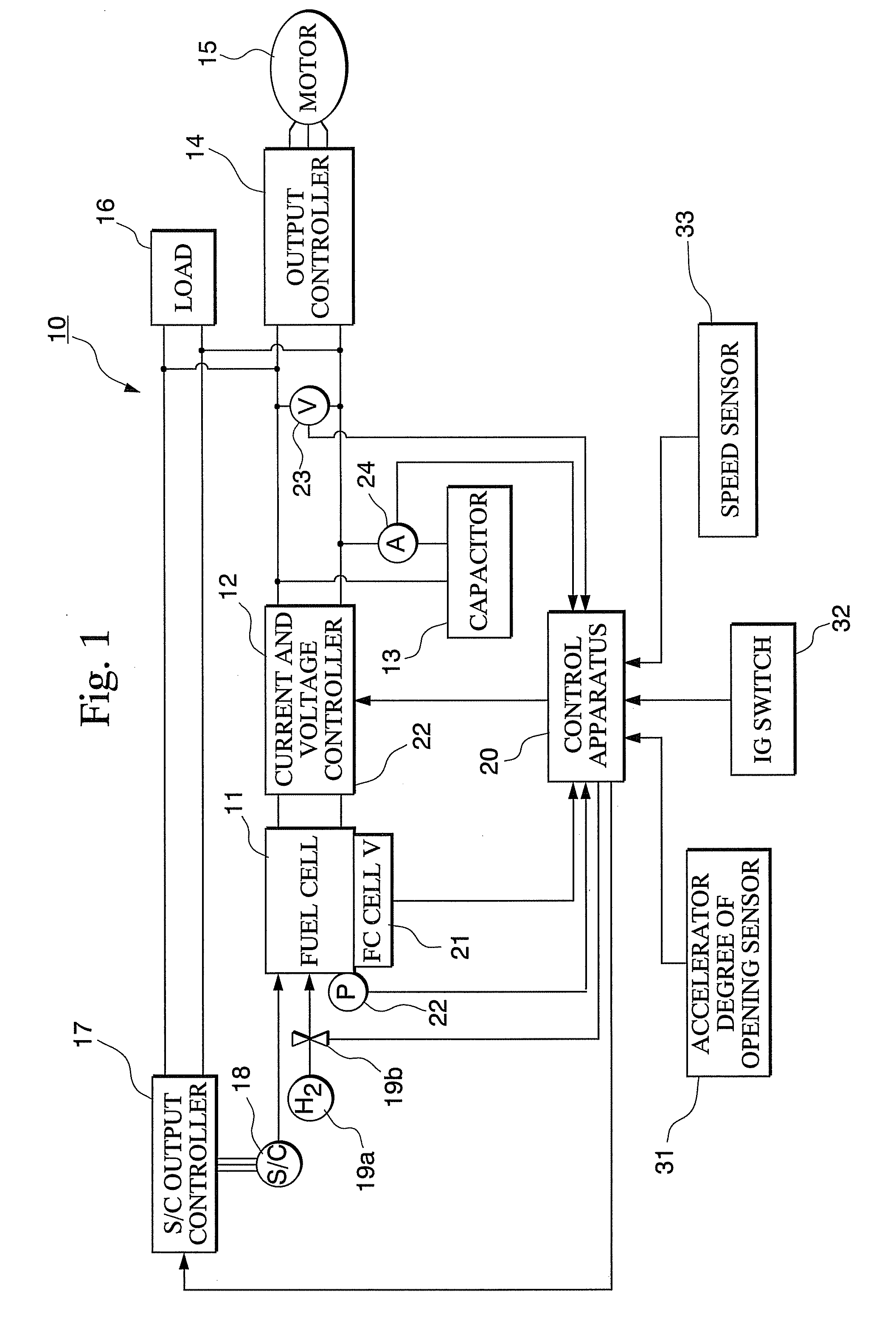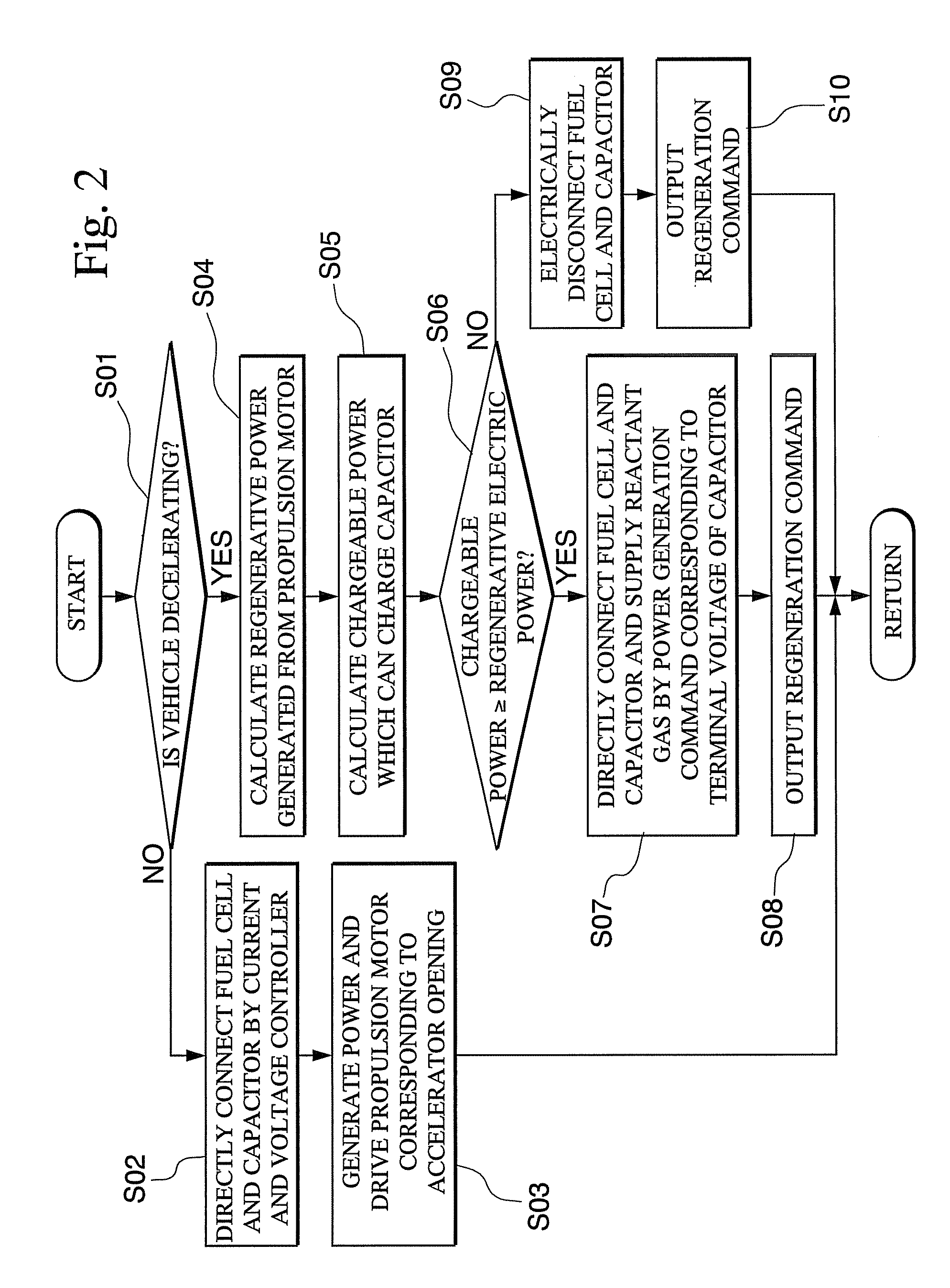Fuel cell vehicle system
- Summary
- Abstract
- Description
- Claims
- Application Information
AI Technical Summary
Benefits of technology
Problems solved by technology
Method used
Image
Examples
first embodiment
[0028]The following describes a fuel cell vehicle system according to the present invention, with reference to the appended drawings.
[0029]A fuel cell vehicle system 10 according to the first embodiment includes for example as shown in FIG. 1; a fuel cell 11, a current and voltage controller 12, a capacitor 13, an output controller 14, a propulsion motor 15, a load 16, an S / C output controller 17, an air compressor (S / C) 18, a hydrogen tank 19a and hydrogen supply valve 19b, a control apparatus 20, a fuel cell unit voltage sensor 21, an anode voltage sensor 22, a capacitor voltage sensor 23, a capacitor current sensor 24, a degree of opening of the accelerator sensor 31, an IG switch 32, and a speed sensor 33.
[0030]The fuel cell 11 includes a stack of fuel cell units made up with an electrolyte electrode structure holding a solid polymer electrolyte membrane formed from a positive ion exchange membrane or the like sandwiched between a fuel electrode (anode) formed from an anode cata...
second embodiment
[0088]The fuel cell vehicle system 110 has the aforementioned configuration. Next is a description of the operation of the fuel cell vehicle system 110, in particular the operation during travelling of the fuel cell vehicle, with reference to the appended drawings.
[0089]At first, in step S01 of FIG. 5, it is determined whether or not the fuel cell vehicle is decelerating, according to for example a time change of the opening of the accelerator related to the accelerator operation amount of the driver, or for example the direction of the current being charged to the battery 13A, that is whether this is a charging current or a discharge current, or the like.
[0090]If the determination result is YES, the flow proceeds to the next step S04.
[0091]On the other hand if the determination result is NO, the flow proceeds to step S02A.
[0092]In step S02A, the duty ratio of the control pulse input to current and voltage controller 12 is set to 100%, and the fuel cell 11 and the battery 13A are s...
third embodiment
[0126]The fuel cell vehicle system 210 has the aforementioned configuration. Next is a description of the operation of the fuel cell vehicle system 210, in particular the operation during travelling of the fuel cell vehicle, with reference to the appended drawings.
[0127]At first, in step S01 of FIG. 8, it is determined whether or not the fuel cell vehicle is decelerating, according to for example a time change of the opening of the accelerator related to the accelerator operation amount of the driver, or for example the direction of the current being charged to the battery 13A, that is whether this is a charging current or a discharge current, or the like.
[0128]If the determination result is YES, the flow proceeds to the next step S04.
[0129]On the other hand if the determination result is NO, the flow proceeds to step S02B.
[0130]In step S02B, the duty ratio of the DC-DC-converter 40 is set to 100% so that electric current from the fuel cell 11 to the battery 13A is not restricted.
[...
PUM
 Login to View More
Login to View More Abstract
Description
Claims
Application Information
 Login to View More
Login to View More - R&D
- Intellectual Property
- Life Sciences
- Materials
- Tech Scout
- Unparalleled Data Quality
- Higher Quality Content
- 60% Fewer Hallucinations
Browse by: Latest US Patents, China's latest patents, Technical Efficacy Thesaurus, Application Domain, Technology Topic, Popular Technical Reports.
© 2025 PatSnap. All rights reserved.Legal|Privacy policy|Modern Slavery Act Transparency Statement|Sitemap|About US| Contact US: help@patsnap.com



